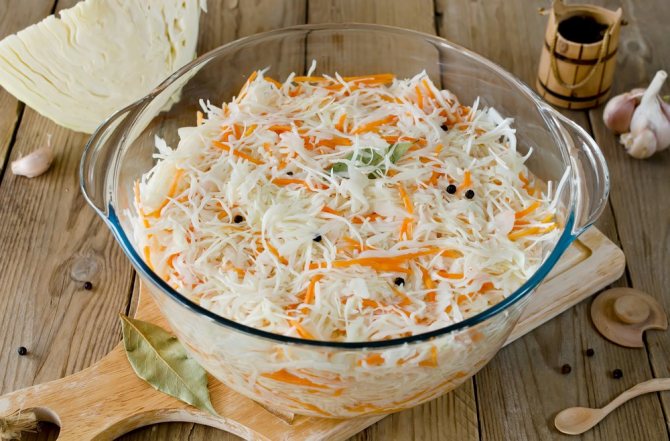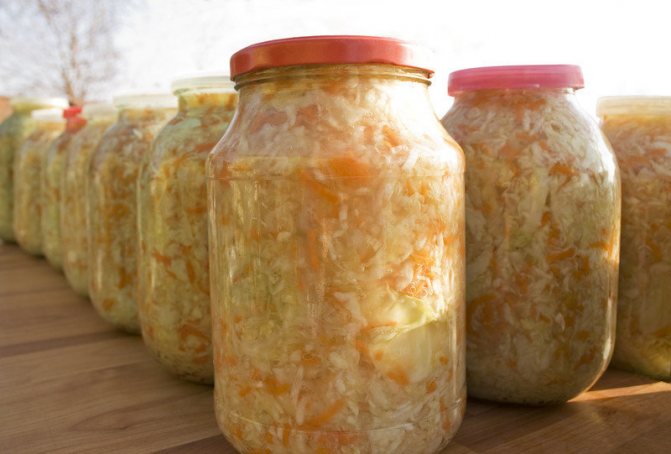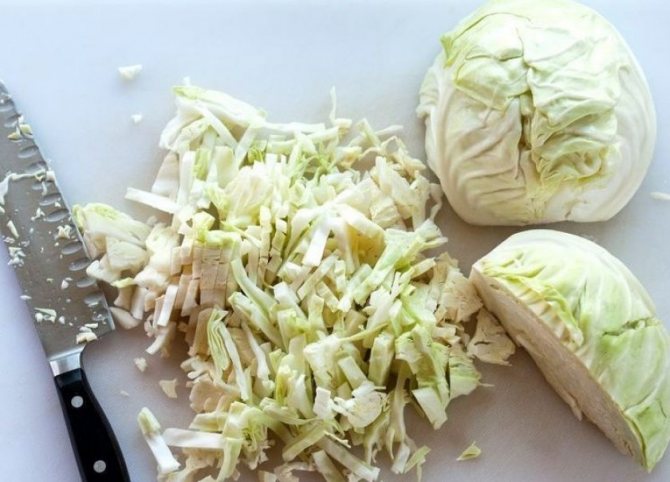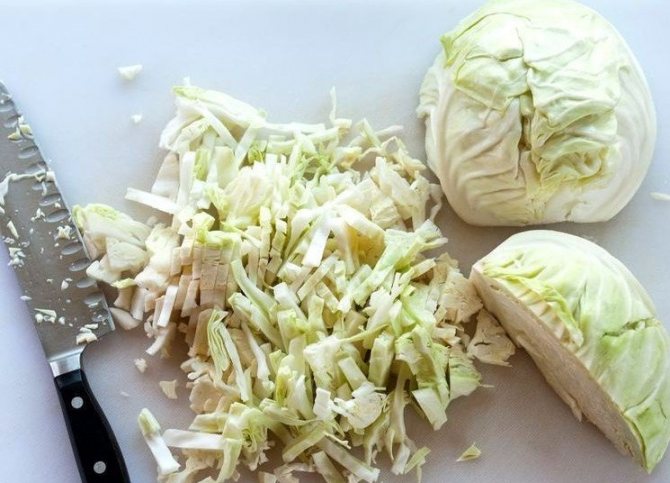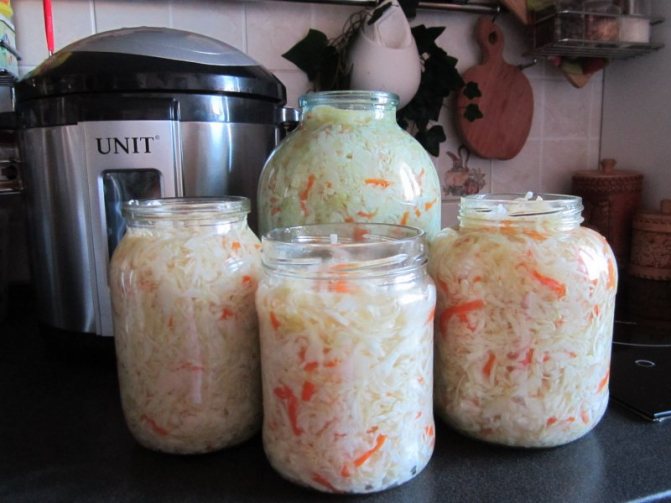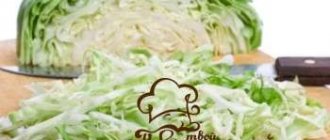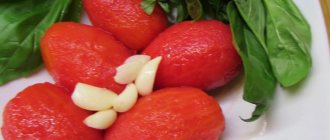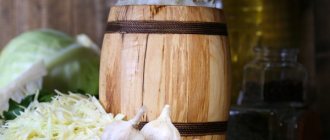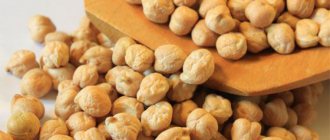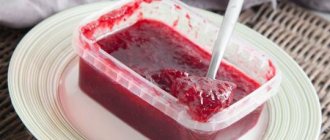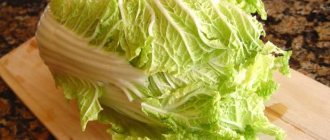Nobody knows for certain who first started to ferment cabbage. Historians claim that the Chinese. Back in the 3rd century BC. the peasants who erected the Great Wall of China were fed cabbage, sauerkraut in rice wine. Russian princes on specially allocated plots of land - skits - grew it for their families and squads, rightly believing that it gives strength and health. In the villages, they put it in barrels - right away for the whole winter. The townspeople do not have such an opportunity: on the balcony it will freeze, in the refrigerator there is not enough space and the temperature is not the same. Therefore, sauerkraut is prepared in small portions.

Certainly, pickling cabbage is one of the most popular ways to preserve it. Compared to salting and pickling, this is a longer process. But on the way out we get not only tasty, but very useful and even medicinal product. In terms of vitamin C content, there is little that can compete with sauerkraut. For pickling, cabbage of autumn and late varieties with ripe dense (preferably large) heads of cabbage, on which there are very few or no green leaves, is ideal. The whiter the leaves, the more sugar they contain, which is so necessary for fermentation (fermentation).
Early varieties of cabbage are not suitable for pickling. Firstly, their heads of cabbage are loose and green. Secondly, they are poorer in sugar, so they are less fermented.
If you are not strong in cabbage varieties, you can determine its suitability for pickling like this: cut the head of cabbage and taste the leaves. They should be white on the cut, crisp and sweet.
The process has begun!
Before shredding, cabbage is not washed, but only green leaves are removed and blackened and contaminated places are cut out. Then the forks are cut into 2-3 parts, chopped or chopped. For every 10 kg of vegetables, take 200-250 g of regular coarse salt (not iodized - it softens the cabbage). But no more: salt inhibits the process of lactic acid fermentation, cabbage does not ferment and acquires an unpleasant odor. In addition, salt removes vitamins and minerals from the vegetable.
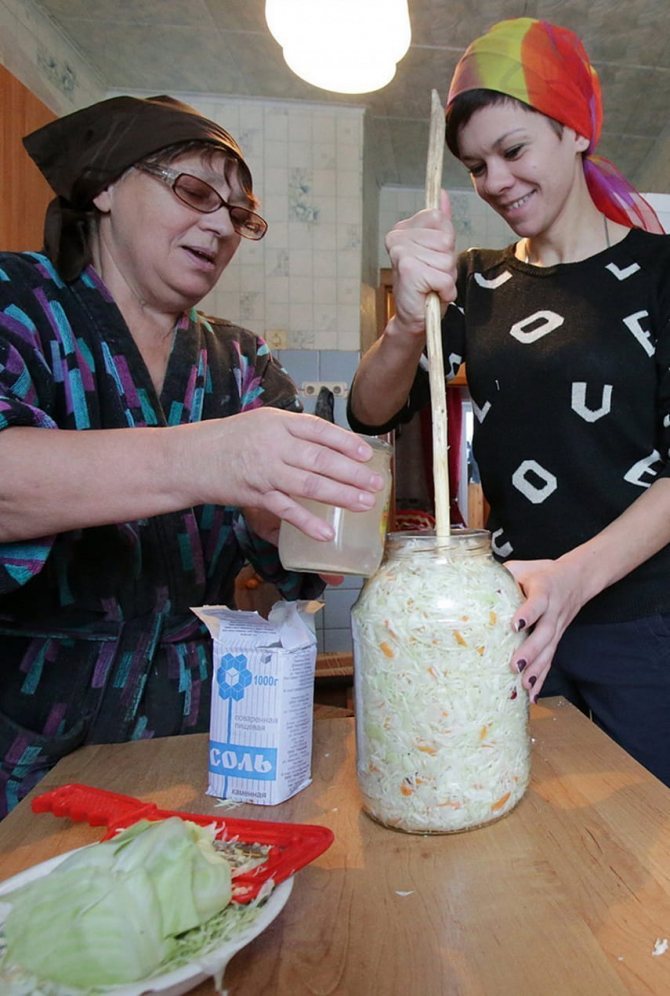

In the old days, it was believed: in order for the cabbage to turn out tasty and crispy, it must be fermented on the new moon. To make it softer - in the last quarter. But the full moon is not at all the right time: the cabbage will be too soft and sour. And they also say that cabbage is great if it is put on men's days - Monday, Tuesday and Thursday.
PHOTO OF MAXIMA EVENING
Place whole cabbage leaves on the bottom of the container and salt them to soften slightly. On top of them - shredded cabbage. And tamp it until the juice comes out. Place a linen napkin on top of the vegetables, followed by a wooden wire rack or porcelain plate. Bends from above (for example, a couple of times scalded cobblestone). Iron, cast iron or copper weights, as well as sandstone or bricks cannot be used as oppression.
REFERENCE
In sauerkraut (or halves) cabbage, 1.5-2 times more vitamins are preserved than in shredded cabbage. Sauerkraut stored according to all the rules contains a high concentration of vitamins for 6-8 months.
After a few hours, foam will appear on the surface - fermentation has begun. Remove foam constantly. At first there will be a lot of it, then less. And when it disappears completely, it means that the cabbage is fermented.And do not forget to often pierce the cabbage in several places to the very bottom of the container (preferably with a wooden stick) or stir to release the resulting gases - hydrogen sulfide and carbon dioxide (if you do not do this, the cabbage will taste bitter). The less air there is, the more vitamin C will be retained in the sauerkraut.
All the while fermentation is taking place (about 10-15 days), the cabbage should be covered with brine. If low, add freshly prepared 3-4% saline solution.
After the sauerkraut has settled (usually for 3-5 days), it is advisable to remove the top brown layer of cabbage and rinse the underside of the circle with a hot solution of baking soda. Then cover the cabbage with a clean linen cloth soaked in brine and wrung out well. Put it under oppression again, choosing its weight in such a way that the brine reaches the edge of the undercutting circle.
Appropriate addition
Other vegetables, as well as fruits, berries and spices added to cabbage, ferment well, are preserved and complement its healing properties. For example, carrots enrich sauerkraut with carotene - provitamin A. Apples share with it vitamins C and P, as well as chlorogenic acid. Mountain ash and bell peppers - vitamin C and carotene. Cranberries and lingonberries - benzoic acid with antimicrobial properties. Spicy plants - bay leaves, caraway seeds, hot peppers, anise - give sauerkraut not only a specific taste and aroma, they contain essential oils and phytoncides that have a detrimental effect on microbes and stimulate the secretion of digestive enzymes in us.
Sour cabbage with juniper berries. They give it a pleasant specific taste and smell. You can also use honey (up to 10 g per 1 kg of cabbage), walnuts, plums, mushrooms.
PROMPT
If it is not possible to store cabbage in an open container for a long time, it is transferred to glass jars and poured on top (two fingers) with vegetable oil. Or canned, having previously pasteurized for half an hour. If the brine is not enough (the cabbage should be completely covered with it), add 2% boiling brine.
WORKING ON ERRORS
Soft sauerkraut is the reason. Why is sauerkraut soft?
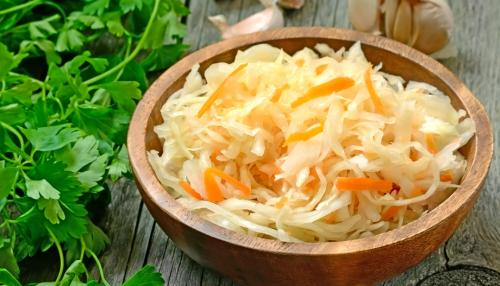

Sauerkraut is harvested for the winter in many families. It is a great addition to many main courses. In addition, in sauerkraut, cabbage retains most of the vitamins and nutrients.
Many housewives are worried about the question: what makes their sauerkraut too soft? This can happen for the following reasons:
- If the cabbage has been frozen, it will not only turn out soft, but it will have an unpleasant odor and a sweetish taste.
- The cabbage, from which you made the preparations, contained a large amount of nitrates.
- Softness and insufficient crunch may indicate that early cabbage varieties were used in the harvesting.
- The reason for the softness of sauerkraut may be the hasty harvesting of the heads of cabbage that have just been removed from the garden. Before harvesting, cut heads of cabbage should lie down for some time.
- During the fermentation process, the cabbage should be pierced periodically to release excess carbon dioxide. If this is not done, sauerkraut will seriously lose not only in taste, but also become softer.
- To prevent sauerkraut from getting too soft, use only strong, large heads of cabbage for harvesting.
- After shredding, do not crush (or crush) the cabbage. You just need to mix it with salt. Use only wooden, glass or enamel containers for the preparation.
- If you follow these simple rules, your cabbage will always be quite firm and crispy.
Cabbage can turn out soft with a little salt. You need to put at least 20 g of salt per 1 kg of cabbage.
The cabbage will be crispy and white, you need to salt it on the growing young moon.
What can be done


How to save an already cooked dish? What to do with cabbage that has changed its appearance and quality? You should not immediately throw out the result of your work. You can't eat such a snack in its natural form, but it can be used to prepare some dishes, for example, cabbage soup.
To use snotty cabbage for certain recipes, rinse it well and thoroughly before starting it in the dish.
Sauerkraut snotty how to fix. Causes of slimy sauerkraut
There can be several reasons for the appearance of mucus in a product - from poor-quality material to a violation of the cooking technology.
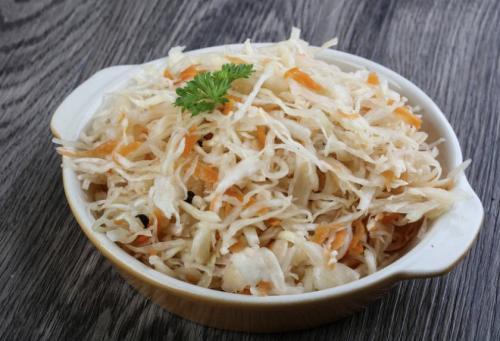

The most common factors that lead to deterioration in the quality of salting:
- high temperature in the room where containers with fermentation are stored;
- busting with sugar while cooking;
- using iodized salt instead of regular salt;
- cabbage contains many harmful additives - nitrates, phosphates and other chemicals;
- selection of an unsuitable variety for harvesting;
- the dishes are incorrectly selected;
- when fermenting, little salt was used or it was too finely ground.
Important! It is possible to salt cabbage well only with the use of coarse salt. Crystals help crush the slices while stirring and gradually dissolve in the container during the salting process.
Consider why the product spoils during the fermentation process, and mucus appears in it.
Wrong choice of containers for fermentation
Cabbage has long been fermented in wooden tubs, barrels, vats. Today, finding such containers, especially when living in a city, is problematic. In this regard, housewives use glass jars or enameled pots. The listed materials are neutral and will not add an undesirable flavor to the dish.
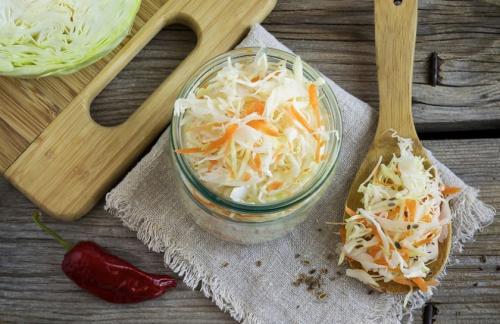

Do not use plastic containers - buckets, large bowls, large cut-off bottles. All of these items can introduce unwanted chemical compounds that, at best, will spoil the taste of the product, and at worst, can lead to poisoning.
Do not use metal containers - aluminum, copper, galvanized or stainless steel. Their surfaces can oxidize, which is why a metallic taste will appear in the sauerkraut, the brine will become viscous, and the unsuccessful salting will have to be thrown away.
Selection of unsuitable varieties
The best varieties for pickling are mid-late and late-ripening. These species spent enough time in the garden to get all the solar energy and nutrients from the earth. Even compared to mid-season varieties, their foliage contains twice as much sugar, which is actively involved in fermentation and fermentation processes.
Did you know? Heads of cabbage, fermented in whole or in halves, retain twice as much trace elements and vitamins as chopped ones. They can be stored for up to 8 months without losing their qualities.
If you try to ferment early or middle varieties, then the fertilizers and growth accelerators that they have assimilated will not only make the brine viscous, but will also be able to destroy the workpiece with decomposition products of chemicals that were part of the dressings.
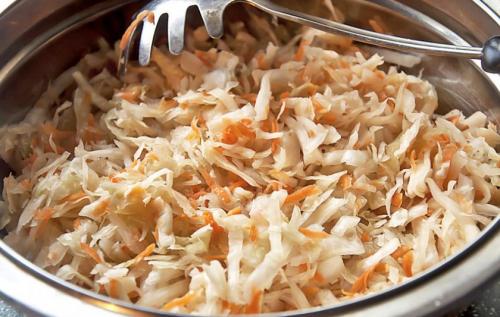

Poor quality additional ingredients
The poor quality of the components noticeably spoils the taste and appearance of salting, which makes the desire to eat it disappear. Depending on the recipe, additional components of the dish are: carrots, black peppercorns, bay leaves, water, salt and sugar. If there are no questions about spices, then the quality of the water used must be carefully monitored.
Did you know? Given the dish's German origins and anti-fascist sentiment in the United States during World War II, sales of the product in the country declined. To save the harvest, the dish was named Liberty Cabbage, after which sales skyrocketed.
For fermentation, only filtered or boiled water is used - if this ingredient is present in the recipe.Carrots should be medium, well washed, peeled and washed again, moderately sweet and free of nitrates. When preparing additional ingredients for addition to chopped cabbage, it is necessary to comply with recipe requirements and health standards.


Violation of cooking technology
In addition to the above, in order for the cabbage to become covered with mucus, it is enough to make one of the following errors in the technological process during cooking:
- poor preparation of cabbage and carrots - the presence of dirt, parasites, hard leaves or peel;
- insufficient or excessive amount of additional ingredients - undersalt, oversalted, a lot of sugar, bay leaves, pepper;
- use when salting a cabbage stump, which is a collection of harmful substances in a cabbage fork;
- the use of heads of cabbage of different sizes and varieties for cutting;
- using dishes with a narrow neck, capping or wrapping - without good contact with air, mucus forms on the cabbage, or it will "suffocate" altogether.
Secrets of pickling cabbage.
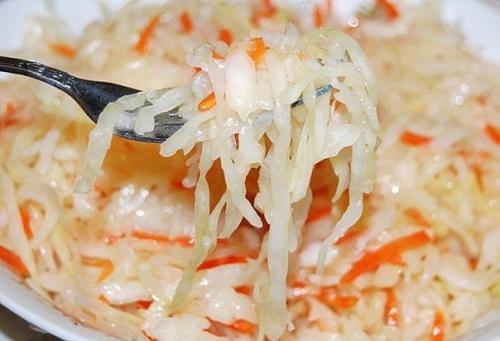

Secret 1. Cabbage varieties. Late ripening cabbage varieties are exceptionally suitable for starter culture. The fact is that cabbage is fermented due to the formation of lactic acid in it, but for this acid to form, the presence of a sufficient amount of natural sugar in cabbage is necessary. This is in late autumn. Secret 2. The influence of the moon. Let's look out the window. Ancient wisdom says that the quality of the leaven is related in an amazing way to the state of the lunar phases. The crispest cabbage is obtained when laying on the new moon. Secret 3. Salt. To obtain a 3-liter jar of ready-made cabbage according to the recipe, 60 g of salt is needed (2 heaped tablespoons). But since late varieties of cabbage contain bitterness and often insufficient sugar content, then it is necessary to put 2 parts of salt (40 g) in the mixture, and 1 part of sugar (20 g). Secret 4. The harm of vinegar. Cabbage should be fermented naturally, without the addition of vinegar. Vinegar (sugar is usually added with it) makes things easier, diversifies the taste of cabbage, but, alas, the benefits are not the same. Maybe only if the vinegar is homemade - it will be a different matter. Secret 5. Oppression. When cabbage is fermented in a barrel, you need a load. And how to organize it if the hostess ferments in parts all winter - in a three-liter jar? Then take a whole plastic bag, pour less than half of water into it, release the air and knot at the very end of the bag. Slowly push the package into the throat of the can, put it all, it presses the cabbage. Secret 6. Supplements. The classic one is grated carrots (about a tenth of the volume of cabbage). Also, when fermenting, apples, plums, cranberries or lingonberries are added to cabbage. Garlic or fresh ginger can be added for a pungent sourdough sensation. But you should not add onions, it will reduce the potential for long-term storage. Secret 7. Spices. For a variety of flavors, there are aromatic seeds: cumin, coriander, cumin or anise. The Caucasian recipe for sauerkraut involves the addition of hot red pepper. A popular recipe for Gurian cabbage with the participation of raw beets (one-sixth of the total volume of cabbage), hot pepper and hot marinade based on wine vinegar (salt, sugar, red pepper, coriander, cloves, vinegar). Secret 8. Form. At the market, grandmothers sell sauerkraut as long as noodles. This method of cutting really affects the taste of the finished product, and it can only be achieved by cutting the cabbage with a special rail. Secret 9. Temperature. The optimum storage temperature for finished cabbage should be between 0 and -2 degrees Celsius. Avoid freezing, otherwise the cabbage will become soft and lose its beneficial properties.
Sauerkraut. How to ferment cabbage at home - useful tips
Our first experience with my husband in pickling cabbage ended in fiasco. It was a very long time ago, in those days we had no idea about computers and the Internet, recipes were copied from each other in a notebook.But I became interested in the intricacies of cooking sauerkraut later, when I had to throw out a bucket of cabbage. The fact is that we bought the "wrong" summer varieties of cabbage, and after the sourdough it became soft like porridge. Many years have passed since then, we have gained experience, which I want to share with you.
- The main thing is to buy or grow cabbage for pickling only of late varieties. Summer cabbage is completely unsuitable for this. In summer cabbage varieties, the leaves are thinner, greener and friable. Winter cabbage varieties are distinguished by a dense head of cabbage and white color. When choosing cabbage, pay attention that it is not too "sinewy", with hard veins.
- Cut cabbage for pickling should not be very small pieces. Each piece should be about 5 mm thick. Chopping the cabbage too much will soften it.
- For sauerkraut, use coarsely ground non-iodized salt.
- Approach the choice of packaging responsibly. For fermentation, glass, wooden or enameled dishes without chips are suitable. In an aluminum saucepan, lactic acid, which is formed during fermentation, will react and ruin your whole business.
- Sour cabbage should be at a temperature not higher than 24 and not lower than 20 degrees. Overheat - you will get jelly, and in a cold room the cabbage simply will not sour.
- The fermentation process takes about 3 days.After that, you can, of course, eat cabbage. But the real taste of classic sauerkraut will appear only after a week.
- Squeeze chopped cabbage for sourdough with something heavy, such as a plate with a 3-liter jar of cucumbers. My grandmother always kept oppression at hand - a wooden circle and pressed it with a clean heavy stone.
- To prevent the gases formed during fermentation from accumulating in the cabbage, it must be pierced in several places with a wooden stick.
- For storing sauerkraut, the ideal temperature is from 0 to +2 degrees. You can put the cabbage in 3-liter jars and then it will be convenient to store it in the refrigerator.
- Cabbage is excellently stored for 9 months. True, the longer it is stored, the sour it becomes. Therefore, it is better to cook all the same in small portions.
- Cabbage retains its properties only when frozen once. You can arrange the sauerkraut into bags and place in the freezer.
- For a delicious crispy sauerkraut, pay attention to the moon phase. It is best to ferment cabbage on the growing moon, after the New Moon in 3-4 days.
Agricultural engineering errors
A bitter aftertaste appears in cabbage if, during the period of growth and maturation:
- the crop was overfed with mineral fertilizers with a high nitrogen content, especially in combination with poorly organized irrigation;
- when processing against diseases and pests exceeded the recommended rate of nitrate application;
- limited feeding with potassium and phosphorus at the stage of fork formation;
- bitter pepper was planted nearby;
- vegetables were harvested early or too late.
The cabbage crop will taste bitter if there has been a prolonged drought during the season, accompanied by high ambient temperatures.
Why sour cabbage sour.


Sauerkraut is not just a traditional appetizer or a component of many dishes on the table of the Slavs, but also a natural healer. It contains vitamins C and K, B vitamins, potassium, iron and many other useful substances. Sauerkraut will increase appetite, enhance the secretory activity of the stomach, and act as a diuretic. Sauerkraut can retain its value for up to 6-8 months. But how to ferment cabbage so that it does not sour all this time is a simple question! There is a special sauerkraut recipe for this.
Recipe. Sauerkraut You will need: white cabbage (chopped - how much is required for a family), 100 g carrots per 1 kg of cabbage, 800 g salt, 8 liters of water, 3 liter cans, natural wooden blocks (width - 3 cm, length - 5 cm, thickness - 1 cm); nylon lids, enamel bucket (10 l).
Preparation: chop cabbage and carrots, mix; pour water into a bucket, thoroughly dissolve salt in it; pour cabbage and carrots into the brine in small portions and keep them in the brine for 5 minutes; squeeze the cabbage and carrots and put them in jars, put the cubes on top; we close the banks with lids and put them on the balcony (in the cellar); we make the next 2 batches of cabbage, keeping each one 5 minutes longer than the previous one (10, 15 minutes); if there is still cabbage, then for the next 3 batches, add water and add 100 g of salt, repeat the sourdough in brine, as with the first three batches. After that, it is not recommended to use the base of this brine again. If you need to ferment the cabbage additionally, it is better to make the brine again.
If you need sauerkraut in a classic form, in a small amount, then the following sauerkraut recipe will do. You will need: a small forks of white cabbage, 80 g of carrots, black peppercorns (to taste), bay leaf (to taste); 80 g of salt, 25 g of sugar, 3-liter jar, nylon lid, water. Preparation: chop cabbage and carrots; put bay leaf, peas on the bottom of the jar, lay cabbage - carrots in layers; make a separate brine - dissolve salt and sugar in water, pour the brine into the jar to the brim; just cover the jar with an inverted nylon lid, put the jar in a deep plate (so the brine will not overflow), leave the cabbage in the kitchen (at room temperature); every 12 hours with a wooden stick, you need to roast the cabbage; on the 3rd day, the cabbage is usually ready. It is important not to allow the cabbage on top to be without brine - top up the overflowing brine from the plate.
Now you know how to ferment cabbage.
Sauerkraut will always come in handy in your home. It can be served not only separately, but also in a hodgepodge, added to strudels, cooked with fried potatoes, made a filling for pies, dumplings, baked closed pies with it, etc.
Many people like to listen to music. Thanks to modern technologies, various novelties appear for high-quality listening to music, such as poweramp for android. PowerAMP Music Player for Android Phone is exactly what you need.
Testimonials
Evgeniya, 64 years old.
Every year I pickle cabbage in three-liter glass jars, never ready-made it tastes bitter. I do not forget to remove excess gases and always follow my old recipes. Guests and relatives - everyone says that the cabbage comes out delicious.
Anastasia, 67 years old.
Every year I cut down all the heads of cabbage before frost, they say that this affects its taste. If I don't have time, then I try to remove everything on the first day of frost. I follow the fermentation process carefully, before serving it to the table, I always check if it is ready. Usually it comes out tasty, and if it tastes a little bitter, then I use it for borscht and cabbage soup.

